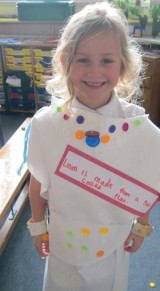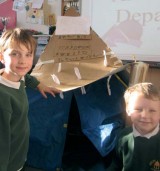Breaking up with the QCA can be hard to do, but schools should if they want children, teachers and inspectors, to subscribe with enthusiasm!
Schools succeed or fail on the strength of their curriculum. With so much at stake, it’s understandable that so many cling tightly to the QCA with its familiar, box-ticking structure. Adhere to the script and there is less danger of falling foul of Ofsted. Stray too far and there’s always the chance of fudging your lines, at least that’s the perception.
But while the QCA might be synonymous with satisfactory performance, to be outstanding requires a little more imagination; not to mention a clear understanding of the educational values that will move learning forward in a specific school with its particular pupils and parents.
This January, the Coalition announced its own revision of the curriculum, the outcomes of which will come into force in 2013. The question for many schools will be what to do in the meantime? Treading water for the next two years might avoid going too far down the ‘wrong track’, but this could be over cautious given that the Coalition’s White Paper promises a slimmed down curriculum that will empower teachers with greater freedom to decide how they want to teach. And besides, the best schools have always been the ones who continually re-evaluate their curriculum, adapting and improving it with each passing year. To wait and see, as Professor Robin Alexander pointed out in an article for the Guardian last year, is to pass the buck. “If schools assume that reform is the task of government alone,” he argues, “then compliance will not give way to empowerment.”
 This was the philosophy of Laurence Pitt, headteacher of Ashley Down Junior in Bristol, when he decided to abandon the QCA back in 2006. Having arrived at the school two years earlier, Laurence was conscious the curriculum needed to be reinvigorated as teaching staff were becoming tired of what they found to be an uninspiring approach. “In 2004 we were following the QCA quite closely,” he says. “In some year groups the delivery was more creative but I think people felt a bit of pressure not to deviate too far from the QCA guidance. It almost felt like people needed permission to do something differently.”
This was the philosophy of Laurence Pitt, headteacher of Ashley Down Junior in Bristol, when he decided to abandon the QCA back in 2006. Having arrived at the school two years earlier, Laurence was conscious the curriculum needed to be reinvigorated as teaching staff were becoming tired of what they found to be an uninspiring approach. “In 2004 we were following the QCA quite closely,” he says. “In some year groups the delivery was more creative but I think people felt a bit of pressure not to deviate too far from the QCA guidance. It almost felt like people needed permission to do something differently.”
Then Laurence received a flyer from EdisonLearning (edisonlearning.net). It outlined two separate frameworks that could be used in tandem: the Core Learning Skills Curriculum and the Connected Curriculum. The Core Learning Skills Curriculum lays the foundation for developing a strong learning culture in the school where children take ownership of their learning, while the Connected Curriculum offers ideas and strategies to help teachers motivate and engage pupils in their learning.
Intrigued, Laurence decided to investigate further. “I went along to one of their presentation evenings with our deputy head,” he recalls. “We thought it sounded very good. Having already done a lot of work on Assessment for Learning, we wanted something that would help us to push this further and develop a creative curriculum at the same time. EdisonLearning seemed to offer the perfect fit.”
Flash forward to 2011 and both EdisonLearning’s Core Learning Skills Curriculum and the Connected Curriculum are firmly embedded at Ashley Down Junior. They’ve also played an important role in the school’s ‘Outstanding’ Ofsted inspection in 2009. So what’s been the key to this successful curriculum reboot? “The Core Learning Skills have been at the heart of why EdisonLearning has worked for us,” Laurence explains. “It creates a culture in which children are constantly self-assessing. By the time our children reach Y5-Y6 they are very capable of talking about learning. They feel in control of their education. It’s a skill for life and it’s what we’ve always been driving towards, but EdisonLearning has given us a systematic way of developing and tracking it.”
Success criteria for Core Learning Skills are incorporated into all lessons at Ashley Down Junior. “It permeates the whole school.” says Laurence, “so if the Core Learning Skill is ‘learning to work with others’, children will make a comment – either recorded or though discussion - about how they’ve managed to work alongside a classmate within every lesson across the curriculum.”
 Compared to the sometimes lacklustre QCA, teachers found the Learning Units presented in the Connected Curriculum to be written in a much more interesting way. EdisonLearning is adding new projects all the time and while these are detailed enough to be used ‘off-the-shelf’, this wasn’t the way forward for Ashley Down Junior. “We didn’t want the Connected Curriculum to just turn into another QCA,” Laurence asserts. What we liked about the package is that it could be adapted to our needs, but it was still a much less time consuming and difficult option than starting from scratch.”
Compared to the sometimes lacklustre QCA, teachers found the Learning Units presented in the Connected Curriculum to be written in a much more interesting way. EdisonLearning is adding new projects all the time and while these are detailed enough to be used ‘off-the-shelf’, this wasn’t the way forward for Ashley Down Junior. “We didn’t want the Connected Curriculum to just turn into another QCA,” Laurence asserts. What we liked about the package is that it could be adapted to our needs, but it was still a much less time consuming and difficult option than starting from scratch.”
 Part of what appeals about the EdisonLearning Connected Curriculum is its creative and sustained approach. “For instance,” says Laurence, “there’s a science focus Learning Unit that involves testing materials. The idea is that for the term (six weeks), you turn your classroom into a Materials Research Academy. One of the challenges is to respond to a request from a company to test different materials for a carrier bag. Our pupils then continued to identify a market for their product and find out how much it would cost. It’s a more positive way of teaching and learning for both pupils and teachers. Projects last for a six week term, and this has really opened up the curriculum. Rather than fitting in a bit of history here and a bit of science there, it’s an approach that allows children to experience deep learning.”
Part of what appeals about the EdisonLearning Connected Curriculum is its creative and sustained approach. “For instance,” says Laurence, “there’s a science focus Learning Unit that involves testing materials. The idea is that for the term (six weeks), you turn your classroom into a Materials Research Academy. One of the challenges is to respond to a request from a company to test different materials for a carrier bag. Our pupils then continued to identify a market for their product and find out how much it would cost. It’s a more positive way of teaching and learning for both pupils and teachers. Projects last for a six week term, and this has really opened up the curriculum. Rather than fitting in a bit of history here and a bit of science there, it’s an approach that allows children to experience deep learning.”
Of course, without knowing how the Coalition’s curriculum review will pan out there’s always a risk in adopting a new approach. But Laurence doesn’t see it this way. “As a headteacher, I would say that if we have something that is working really well and our children are engaged with their learning and making very good progress then, actually, we’ll carry on in a way that will maintain those achievements. I am sure we can adapt anything we want in order to cover National Curriculum requirements and I am pretty positive that EdisonLearning will help us to come up with a creative way for children to achieve those goals.”
For more information about EdisonLearning, visit edisonlearning.net, or call 01376 562953.
Three great learning contexts from the edisonlearning connected curriculum…
 1. Turn your classroom into a research academy, testing scientific issues for companies. Can the children find suitable materials for a new carrier bag product?
1. Turn your classroom into a research academy, testing scientific issues for companies. Can the children find suitable materials for a new carrier bag product?
2. Pupils become town planners. The book Window, by Jeannie Baker, is used to provide visual support and stimulation alongside the development of an imaginary town.
3. Princess Cinderella and her husband had a fantastic banquet after their wedding. The king decides that the caterers can plan a thank you party – remembering the kingdom’s low fat and sugar policy!
How to be a singing school
Ace-Music
Kindness is contagious - give your colleagues a boost by recognising their efforts
Ace-Classroom-Support
